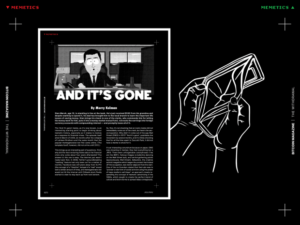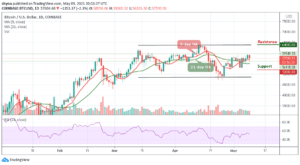Bitcoin’s finite supply poses challenges to big banks’ traditional tactics of price manipulation.
Part One: But This Is How We’ve Always Done Things …
There is a great story floating around the web about a married couple and a ham (full story). In brief, the wife is preparing a ham for dinner and in doing so, cuts approximately 1 inch off of two sides of the ham and throws them away. The husband, visibly upset, proclaims, “That’s a waste of good ham!” When asked what the rationale was, the wife didn’t know, simply stating that this was the way that her mother had done it.
Later, the wife called her mother and asked her why she cut the ends off, to which she replied, “That’s the way my mom prepared the ham.” The wife’s grandmother had passed, but her grandfather was still alive and when he was asked why his late wife cut the ends of the ham off he replied, “So the ham could fit in the baking pan.”
The tale revolves around cultural training at its heart, but the story is really something many of us can relate to and the notion of: this is how we’ve always done things. With ETFs, derivatives, futures contracts and long/short positions on bitcoin all coming into the space within the past few years, traditional financial may be in for a rude awakening when what they used to do, no longer works.
Big banks have been accused of price manipulation in the silver and gold markets for years; however, a debate exists in regard to if this manipulation is as pervasive as conspiracy theorists suggest, or if perhaps even worse (InvestingNews, 2022). Between 2008 – 2016 J.P. Morgan admitted to wrongdoing and agreed to pay a $920 million penalty (Reuters, 2020); one may consider how the debate has evolved since the news broke and whether conspiracy theorists were actually whistleblowers, with “scarlet-letter Ws” which needed to be removed.
The paper precious metals markets are a unique animal in regard to not only derivatives, futures and long/short positions; they are special in that instances of physical delivery are few and far between. Often, settlements are conducted through the same paper markets and no physical metal is ever exchanged, nor verified, moved and stored in another location (Journal of Financial Services, 1990). Bitcoin can be settled more quickly of course. There is no third party precious metal audit, no massive freight trucks, no armed guards and no shipping containers to move cargo overseas. In the slow, cumbersome process of precious metals validation, big banks have seized an opportunity to correctly call the bluffs of paper traders and settle positions, with additional paper versus the burden and inconvenience of physical delivery. Bitcoin removes this burden and, in an instant, liquidated positions could be required for delivery, even in paper market scenarios. The way that big banks have manipulated the precious metals markets may backfire when attempting to use the same playbook on an asset that can be verified and delivered in minutes.
Part Two: Back Up The Bus
I love the phrase, “I missed the bus.” The visual of a middle school kid sprinting to a bus stop, lunchbox firmly grasped in hand and backpack violently bouncing behind them, only to arrive and see the tailpipes of a giant, yellow, Twinkie-shaped vehicle disappear in a plume of diesel smoke, makes me want to be a kid all over again (okay, maybe not so much). The next scene is usually the same kid, head hung low, backpack slowly shifting from side-to-side, lunchbox barely being held on with a finger or two, feet dragging one painful, broken and defeated step after another as the child drags themselves through the final mile to school.
I propose that some folks see themselves as those kids when they look back at bitcoin’s price below $1, $100, $1,000 or $10,000. They wonder if they missed the bus. For regular investors, going back in time is not an option, however, for big banks in my scenario, they can attempt to bring the bus back and get on. Nevermind that everyone who was on time now has to wait while the kid who slept in steps onto the now-retreated bus and proceeds to make everyone else late.
I propose that big banks, when they finally get their legal counsels on board, when regulators capitulate and state that they personally own bitcoin and are now allowing this entity or that entity to own it as well on their balance sheets — or when corporate treasuries have increased exposure to bitcoin — will attempt to back up the bus, get on board and pretend like the price manipulation never occurred. Big money who missed the bus will work to lower bitcoin’s price via negative media, fear and the typical playbook antics of the past, in order to maximize pain on retail investors, HODLers and institutions which already have bitcoin on their balance sheets.
The cruel reality for whales — future and present — is that the same instruments used to manipulate prices in the precious metals markets are being created in the Bitcoin universe, but not to their advantage. As such, regular, hard-working people, from around the world, can set limit orders and dollar cost average into positions. When whales sell off in an attempt to manipulate the price and buy back in at lower valuations, regular investors take a little piece here and there. With around 19 million of the total 21 million Bitcoins already mined and many in cold storage (or lost), each “pump and dump” scenario is a roll of the dice for large positions to potentially not recover their previous holdings. Moreover, with centralized exchanges and confiscation issues taking center stage, cue Canadian governmental theft of protestors’ and supporters’ personal property, cold storage options are becoming the norm for regular people.
Yes, price volatility is scary in the short term, and it will get worse before it gets better. Remember who you’re dealing with. Big money does not care about you, your position or your well-being. They care about maximizing profits; and those profits are maximized when retail sells. So don’t sell, and work to play the game better than they can. They have quarterly reports, investment targets, objectives and stakeholders; retail investors have the luxury of time if they play their cards right and that is a powerful weapon if wielded correctly.
As a result, in the long term, HODLers will have more than enough opportunities to get on the bus as whales attempt to wind back the hands of time with their “tried and true” tactics of manipulation. The challenge that big money will face is something they have never faced before – limited supply, halvings and a massive worldwide demand. Whales and others will be competing for coins and fractions of coins with a cell phone owned by a child at a bus stop in a different country; and they’ll be competing with you, and millions (or billions) like you.
Part Three: Whales And Minnows
Global demand for bitcoin will not see an end. The fiat currency cat is officially out of the bag. At a restaurant a few weeks ago I asked the waiter how they divided their tips at the end of the night, wondering if it was equitable; they stated in no uncertain terms, “It’s great. Everyone gets a piece, from the front staff to the back of the house. We count the total tips and then instead of breaking it up and getting paper money or coins, the owner deposits bitcoin into each of our digital wallets each pay period.” This floored me. After speaking to the manager (I’m old, we do things like that) he stated, “I care about my team and with inflation, I can’t afford to pay them more and more each month, but I can be creative and convert a depreciating currency into something that they’ll want in 20 years; this helps me retain talent and rewards them with an insurance policy for the future.”
The whole situation was mind-blowing, but the “insurance policy” rationale is what I want to focus on. Each year, millions of people spend money on insurance, in hopes that they never need to use it. This restaurateur was attempting to provide a future financial safety net to his employees by taking the time to convert fiat U.S. dollars to a potential future global store of value, bitcoin.
These restaurant employees, greeters, cooks, staff and dishwashers are the ones who are incrementally shaving away pieces of the future 21 million fixed supply of Bitcoin. This should terrify big banks, whales and global elites. Each time the price dips, regular people can accumulate more, not less. The daily, weekly or monthly purchases of bitcoin slowly and methodically consume the available supply. Yes, whales have the ability to move large quantities of bitcoin at one time or another and a massive sale can temporarily lower the price. There are other whales, however, waiting to scoop up supply and an ever-increasing global army of minnows, taking custody of fractions every second of the day.
Part Four: Slow Down To Speed Up
When bitcoin was nearing $70,000 in 2021, euphoria seemed to overtake the airwaves and when a dump brought the price down below $30,000 a few months later, the bubble had burst, right? It wasn’t that long ago that bitcoin’s price was $300, then the price “dumped” and each BTC was worth less than $100. Were any of these prices “bad” purchases if the position was held? No, at each price level, accumulators of bitcoin added to their position. At close to $70,000 per BTC, one purchased less of the asset, at $30,000 they could purchase more with the same amount of fiat dollars. This is the way to think about your position. Price dips are sales of the most precious, globally-known asset on earth. Remember that we have only had three of 64 scheduled halving events in Bitcoin’s history: Yes, you’re still early.
How will you feel if bitcoin’s price dips below $30,000 tomorrow? How about $20,000 or $10,000? Is this a time to panic or is this the bus backing up so that you can get on? If you already have a position, yes, your dollar-denominated perceived value, on paper, is down, but your BTC holdings have not changed. That’s the game you’re in: 1BTC = 1BTC.
Big money will work to spread fear, uncertainty and doubt (FUD) in an attempt to have you release your grasp on your insurance policy for the future. Don’t fall for it; your BTC holdings are your future seat at the table. Continue to add to your position, continue to hold, and continue to remind yourself that as the prices dip, your position grows with each purchase made, no matter how small. This doesn’t matter if you’re a whale, a minnow, or something in between. Holding and accumulating a position only reduces the future available supply and that is a good thing for you and your insurance policy. Whales will continue to attempt to play musical chairs; however, they are going to be playing with a group of people who might, just might, refuse to stand up someday and give up their seat. When a whale gives up a large position (seat) in the future, they may never get that seat back.
This is a guest post by Dr. Riste Simnjanovski. Opinions expressed are entirely their own and do not necessarily reflect those of BTC Inc or Bitcoin Magazine.





















